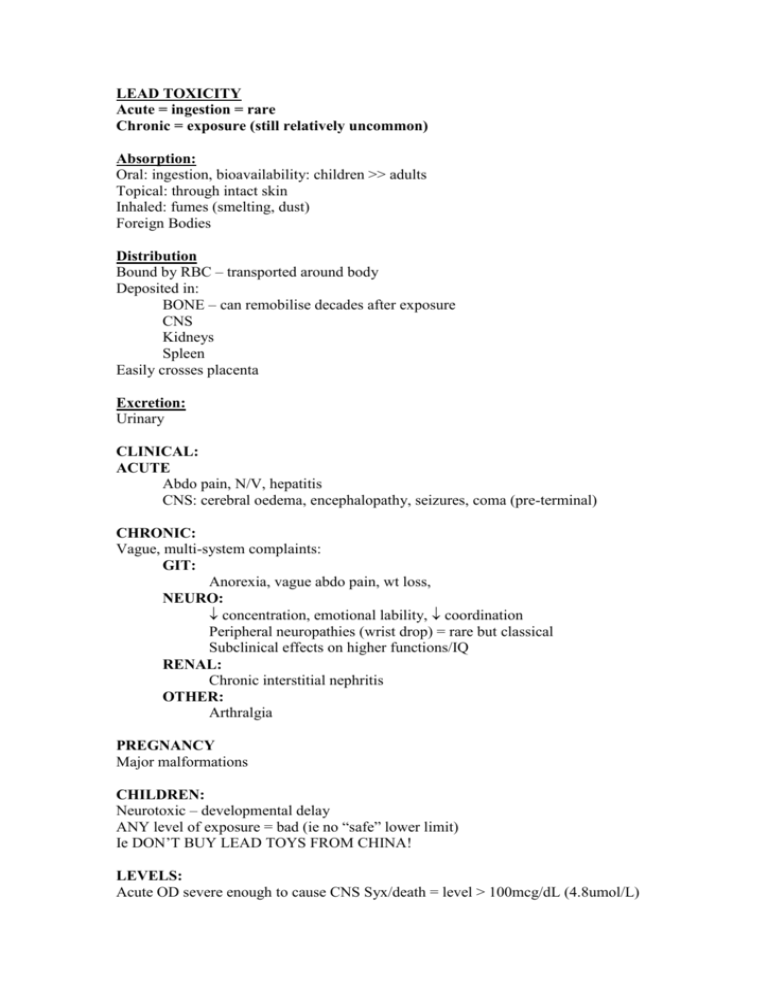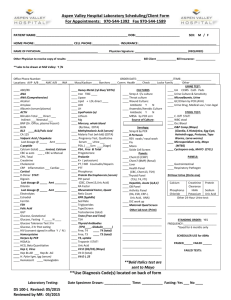LEAD TOXICITY
advertisement

LEAD TOXICITY Acute = ingestion = rare Chronic = exposure (still relatively uncommon) Absorption: Oral: ingestion, bioavailability: children >> adults Topical: through intact skin Inhaled: fumes (smelting, dust) Foreign Bodies Distribution Bound by RBC – transported around body Deposited in: BONE – can remobilise decades after exposure CNS Kidneys Spleen Easily crosses placenta Excretion: Urinary CLINICAL: ACUTE Abdo pain, N/V, hepatitis CNS: cerebral oedema, encephalopathy, seizures, coma (pre-terminal) CHRONIC: Vague, multi-system complaints: GIT: Anorexia, vague abdo pain, wt loss, NEURO: concentration, emotional lability, coordination Peripheral neuropathies (wrist drop) = rare but classical Subclinical effects on higher functions/IQ RENAL: Chronic interstitial nephritis OTHER: Arthralgia PREGNANCY Major malformations CHILDREN: Neurotoxic – developmental delay ANY level of exposure = bad (ie no “safe” lower limit) Ie DON’T BUY LEAD TOYS FROM CHINA! LEVELS: Acute OD severe enough to cause CNS Syx/death = level > 100mcg/dL (4.8umol/L) INVESTIGATION: General: ECG, BSL, Paracetamol Specific: Whole blood lead level: most useful indicator of exposure FBE: Anaemia U&E, LFT FEP (Free Erythrocyte Protoporphyrin) Surrogate marker of total body lead level AxR: lead ingestion Chronic: Nerve conduction studies Psychomotor testing MANAGEMENT: 1) Risk assessment: High Risk Acute ingestion Children Pregnant Altered conscious state/CNS Syx 2) Resuscitation: ABC/IV/O2/monitor Cerebral oedema: mannitol/steroids Seizures: treat as per usual Supportive care and monitoring 3) Decontamination Above Gastro-oesophageal junction Endoscopic removal Below Gastro-oesophageal junction Asymptomatic High fibre diet Laxatives: polyethylene glycol Repeat AxR every 24hrs aim passage <72hrs If still present at 72hrs: Admit Whole bowel irrigation (polyethylene glycol) 4) Enhanced Elimination Not clinically useful 5) Antidotes = CHELATION: General Idea: IF ICU sick (can’t tolerate oral therapy) Dimercaprol + EDTA Don’t give EDTA alone (can cause redistribution of lead to CNS) IF able to tolerate oral therapy Succimer 1) Dimercaprol Adjunct to EDTA But best if given few hours before Only used in ICU due to 1) Side effects 2) Severity of condition Also used in: Arsenic, Mercury, Gold, other heavy metal toxicity Given IM, 4 hourly, started 4 hrs before EDTA Binds metals excreted in urine (and also removed by dialysis) Formulated in peanut oil (CI – peanut allergy) SE: Nephrotoxicity (due to dissociation of metal in kidney) alkalinise urine to this effect Pain/sterile abscess at injection site, fever, myalgia, CP/HT/HR, headache, N/V, paraesthesia, burning lips, lacrimation/salivation Haemolysis in G6PD Tips: NEVER GIVE IV Most effective ASAP afer exposure Treatment with Succimer always preferable Difficult to obtain only stocked at a few hospitals 2) EDTA (Na+/Ca2+ Edetate) Indication: Lead Encephalopathy Severely symptomatic and/or Level > 100mcg/dL Mild/no Syx & level >70mcg/L 2nd line if DMSA not available/tolerated Other heavy metal poisoning (efficacy unknown) Contraindication (relative) = anuric renal failure Given IV Infusion runs over 24hrs, starting 4hrs after Dimercaprol Max 5 days Once clinically improved can switch to oral Succimer Binds metals excreted in urine (and also removed by dialysis) SE: pain phlebitis, fever, chills, myalgia, headache, anorexia….lots more Nephrotoxicity (due to dissociation of metal in kidney) Minimise by adequate urine flow, max 5 days, monitor Cr/RF 3) Succimer (DMSA) Indications: Able to tolerate oral therapy Symptomatic + no encephalopathy (ie not needing ICU) Asymptomatic + level > 60-70mcg/dL (adult) >45mcg/dL (child) Other heavy metals: arsenic, bismuth, copper Water soluble analogue of Dimercaprol Binds heavy metals excreted in urine Lead poisoning: Can give as outpatient Oral dose (10mg/kg) tds for 5 days Check levels after treatment treat again if levels rise Can use after IV treatment in sever poisoning SE: Foul smelling – GIT upset, Hypersensitivity, others May be difficult to acquire – only available under “Special Access Scheme”






